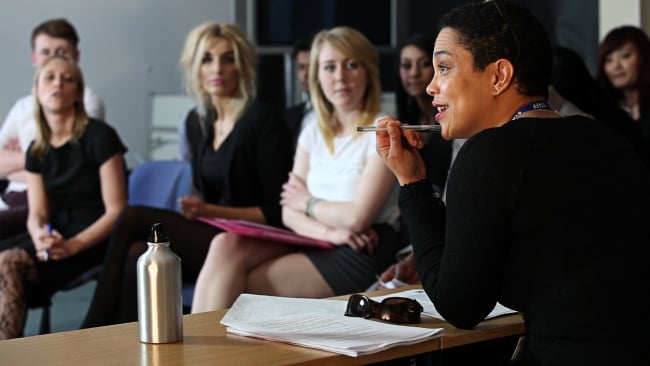You have /5 articles left.
Sign up for a free account or log in.

istockphoto.com/ContentWorks
When I began teaching in the late 1990s, the classroom behavior statement in my syllabus was three sentences long. Now it runs to a page. Are students that much more ill behaved 20 years later? Or have the academic landscape and the manner in which professors are expected to manage student behavior shifted dramatically?
A year or so ago, I gave this topic zero thought. But on Nov. 9, 2016, our nation experienced a seismic shift. Suddenly, educators across the country reported a spike in instances of incivility, bias, hate speech and bullying in classrooms -- from elementary schools to the college level. Entitlement was coupled with a new national “role model,” and some students felt it appropriate to speak of immigrants, people of color, GLBTQ students and many others in problematic ways.
Some students confuse civil speech with their “right” to free speech. One of my classes included a student who used expletives like punctuation and ended many sentences with one. When reminded of the class policy on language, he yelled at me, “I can say whatever I want to! It’s my right to free speech!”
Other students act as if people of color or a protected class are not in the room when they speak of them. A student in my writing course stated that “there’s no such thing as white privilege” and made remarks about Trump’s first travel ban that offended Somali students.
This is a balancing act, of course; students can’t be entirely protected from hearing sometimes painful speech. New and different perspectives push us out of our comfort zone; part of my job is to create these kinds of learning experiences. That said, I have yet to meet a student in my classes who took the position that he/she should not have to hear opinions that differ from his/her own.
I teach writing and literature through the lenses of race/class/gender/faith and the ways in which we define identity and build community, so I quickly found myself on the front lines of this brave new world where some students felt entitled to disparage others and disrupt the learning environment. I was not going to stop teaching Malcolm X or emigration narratives just because our national politics had become personal. But I needed to add some new tools to my toolbox. Here is what I learned.
Know Your Institution’s Policies
Read your college’s student code of conduct. What does it say about hate speech, bias incidents and disruptions in the learning environment? Put this language and a link to the entire code in your syllabus. Share it with students the first week of class. Give examples of what crosses the line.
Also state your own classroom policies in your syllabus. Do not just share them verbally or assume students will “get it” based on the climate you create in your classroom. Those days of assuming respect and authority are over.
Last semester, my writing class included a high percentage of immigrants, an ex-Marine and a student with severe anxiety. I worried about a fistfight breaking out if the “white privilege doesn’t exist” student continued to speak his mind without using a filter. During one-on-one meetings, we talked about increased self-awareness, “audience” consideration and the value of sensitivity, but he was often confrontational with me and argumentative with his classmates. I pointed to college policy, then realized I needed to make my own syllabus more specific because some students see free speech as any speech and do not believe they need to temper their comments for anyone’s sake.
My goal was not to censor student voices, but rather to ensure that one student’s right to free speech does not interfere with another student’s learning experience or sense of safety.
Visit the Student Conduct Office
What? I have a student conduct officer? I hope you do; this person may handle Title IX, VAWA and other federal programs, but this is also the person who is trained to talk with students about expectations for speech and behavior. This person also has your college’s legal counsel on speed dial and understands federal mandates and protections.
Your student conduct officer is your first point of contact, but I suggest contacting her before you ever have an incident in your classroom. Find out the process for reporting incidents -- and the levels. Some colleges have a report used to document “a student of concern” prior to a serious incident taking place. This report puts the conduct officer on notice and creates the first step in a chain of documentation if the situation escalates. The first time I used it, I was uncertain if my student “qualified” for this designation, but a conversation with the conduct officer helped me better understand the warning signs and issues.
A colleague with a military veteran in her class recognized warning signs when the student acted angry and almost threatening in class. “His memories were fried and he was trying to cope, but he just wasn’t ready for college yet,” she told me. This instructor knew he was undergoing therapy for his PTSD and reached out to the conduct officer to get the student help before the situation escalated, then learned that several other professors also had sought support for this student.
Know Your Campus Resources
Once you’ve talked with the conduct officer, get friendly with your campus security officers, counselors and the student affairs division. If a student acts out in your classroom, you’re going to need a team. I feel fortunate that my campus takes this team approach.
Student services may have assembled a behavioral intervention team that includes these people and a few others with specialized training. When a student acts out, uses hate speech or is threatening, these professionals view it as a cry for help, not a crime. The key is to keep the student and faculty member safe while underlying issues are examined and support is sought for the student.
Maybe the student is homeless or dealing with a risky home environment. Perhaps there are financial stressors. Each person’s life is layered, and what we see on the outside -- inappropriate behavior -- may be linked to a range of underlying issues. The intervention team tries to look at the whole person and find underlying causes and ways to resolve the issues so the student can function well in school.
Speak With Campus Security
Security works closely with the student conduct office on my campus, and they are proactive in supporting faculty and keeping classrooms and hallways safe. Before I spoke with them, I did not know that a phone call to their main number (which I memorize and also post in my classroom) goes to every walkie-talkie on every officer’s hip.
I also did not realize that the new phones installed in each classroom on my campus have three large buttons, and one goes directly to security. That means they’re on speed dial. Once security is dialed, our system is configured to allow what is happening in the room to be heard by every security officer on campus. Knowing that simple fact gave me a sense of increased safety. If a student became explosive in my room, I could knock the phone off its hook, hit one button, and security would be on its way.
Your security officers can explain policy, but they can also offer great advice on dealing with tough cookies. It might be worth a few minutes to sit down with the director, describe what you’re dealing with in your classroom and solicit advice. Discussing past incidents and how you handled them is wise, too; you may learn some new tips and better ways to handle a disruptive student.
If you find that your campus security resources are lacking, bring up the issue with administration. Remind them of the precautions taken in the public schools. You deserve a safe teaching environment and the ability to respond to an escalating or dangerous situation in a manner that protects both you and your students.
Do Some Self-Care
We all want our institution’s values to line up with our personal values when it comes to inclusion, respect, diversity and free speech. If that is not the case, stay realistic. Do not take it personally. Perhaps your school needs to catch up with the rest of higher education, and you can nudge administrators in the right direction. Having clear policies and procedures, a student conduct office, and trained counselors is not just good institutional practice; it could save the school in an emergency or lawsuit.
Challenging students can be exhausting. Look for ways to recharge. I meditate for five to 10 minutes in my office, using a simple YouTube video. Meditating is a car wash for my brain, and it resets the emotional clock to a positive position so I can be mindful and compassionate as I interact with my students, rather than reactive.
The uncivil student may consume an unfair percentage of your attention and energy, but he’s not your only student. Make choices and decisions that are in the best interests of your entire class; don’t ignore their needs to placate one individual. When one student’s words or behavior interfere with other students’ learning or sense of safety, there is an issue.
As faculty members, we are on the front lines. The decisions we make and the cues we give our students regarding personal and professional accountability do influence our campus climate (and hopefully our national one). We want all students to feel safe, valued, included and respected. Setting clear boundaries and modeling respectful speech and behaviors is where we begin.








